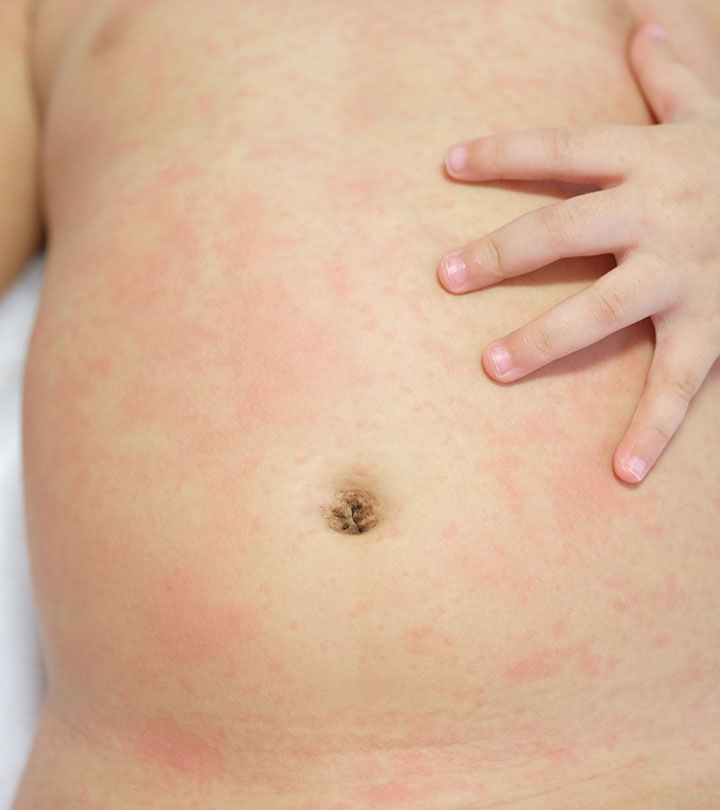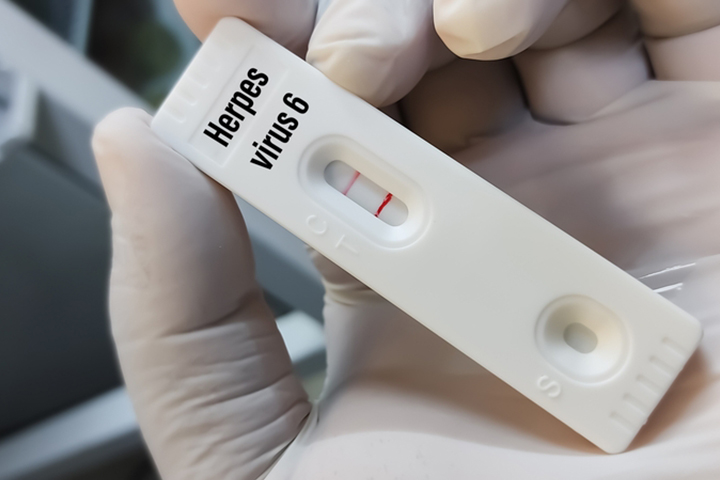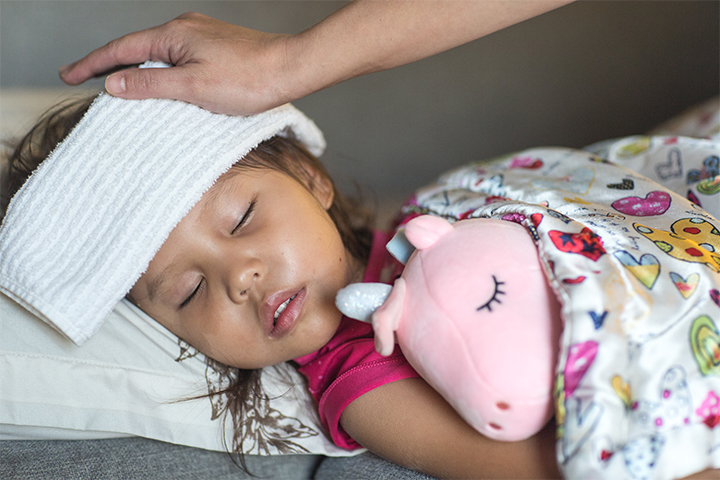Exanthema subitum, roseola infantum, or roseola in toddlers is caused by a viral infection. It is also referred to as the sixth disease and presents as rashes appearing all over a toddler’s body. The symptoms start with a high fever, and the rashes appear only after the fever subsides.
Keep reading this post to know more about the causes, symptoms, diagnosis, complications, and treatment of this viral disease in toddlers. Also, learn about how toddlers contract this disease, whether it is contagious, and other frequently asked questions about roseola, such as whether a toddler can contract it more than once.
What Is Roseola And What Causes It In Toddlers?
Roseola is a viral childhood disease caused by an infection from the human herpesvirus 6 (HHV-6) or herpesvirus-7 (HHV-7). HHV-6 is a more common cause of the disease than HHV-7 (1). Both HHV-6 and HHV-7 belong to the same family as the herpes simplex virus and the varicella-zoster virus that causes chickenpox and shingles (2). A baby of any age can get the disease, but it mostly affects infants and toddlers between six months and three years (1).
How Does A Toddler Get Roseola?
The HHV-6 or the HHV-7 virus that causes roseola transmits through the nasal and oral route when a toddler inhales the virus. Transmission could happen when an infected person sneezes or coughs scattering tiny saliva and mucus droplets in the air. The virus can also land on surfaces. A toddler can catch the infection when he inhales the droplets or touches the contaminated surfaces and puts his hands in his mouth or nose (3).
Is Roseola Contagious?
Roseola is the most contagious disease in the fever phase (3). It is a communicable disease that spreads through coughing and sneezing and can significantly impact a child’s health. By the time the toddler has a rash, the fever is gone, and the condition ceases to be contagious.
In the same way, a toddler contracts the virus on inhaling the sneeze/mucus droplets of an infected person’s sneeze or cough only when that person is in the fever stage. Coming in contact with the rash does not cause roseola because the rash does not transmit the virus.
What Are The Symptoms Of Roseola In Toddlers?
The incubation period for the roseola virus (both HHV-6 and HHV-7) is one to two weeks (4). A toddler will display the following symptoms of the condition (5):
- High fever is the first symptom of the condition and comes without rashes. The roseola fever is on the higher side, at least 103°F (39.5°C) or above. The fever can last between three days and one week.
- Both eyelids swell making it difficult for the toddler to see.
- The toddler refuses to eat and might have a mild diarrhea.
- The baby may have a mild cold, runny nose, and a slight cough.
- General fussiness along with drowsiness.
- Flat, pink rashes appear 12 to 24 hours after the fever has subsided. The rashes could be dark or light pink, and appear randomly scattered, but are not itchy and do not cause any discomfort. The rashes first appear on the chest and stomach followed by the back and other body parts. The face is the last place where the roseola rashes appear. The rash stage lasts for a few hours to three days.
Karyna Cast, a vlogger and mother of four, notes slightly different symptoms of Roseola among her two children, “Mikhaela (her daughter) had a very high fever (104 °F) all of a sudden, and it probably lasted for about three or four days, with no other symptoms. Leonardo (her son) had a fever, but he had it only at night, and it was a low-grade fever, and during the day, he would have just a little elevated temperature. In three days of fever, he developed a rash, but his symptoms were not as bad as Mikhaela (i).”
The toddler feels fine and appears healthy through the rash stage. But, do remember that if the condition goes untreated, it could lead to adverse effects.
What Are The Complications Of Roseola In Toddlers?
Roseola could have a few complications in toddlers.
- Febrile seizures are seizures accompanied with high fever mostly in babies and toddlers who are between six months to five years (6). Since the seizures along with a fever, they are called febrile seizures and are different from the seizures that occur during epilepsy. Febrile seizures happen only for a few minutes and rarely extend up to 15 minutes. During a seizure, the toddler’s limbs and body will twitch, shake, and he may roll awkwardly on the floor. While the situation could be unsettling for the parents, its occurrence is limited to high fevers. It is not known what causes febrile seizures, but are more common in toddlers with a family history of seizures, suggesting it could be a genetic problem.
- Pneumonia, which is a bacterial infection of lungs, is quite likely to happen in toddlers who suffer from chronic lung infection or disease, and have contracted roseola too.
- Encephalitis, the bacterial infection of the brain, is another complication that leads to severe pain and inflammation of the brain.
The condition should be attended immediately and a thorough diagnosis becomes the first step to ridding the toddler of the disease.
How Is Roseola In Toddlers Diagnosed?
Roseola can be difficult to diagnose as the initial symptoms resemble any other standard illness. First, the pediatrician will need a medical history and physical examination. Then, they may suggest other tests to confirm the infection.
How Is Roseola Treated In Toddlers?
As roseola is caused by a virus, there are presently no treatments available for it, such as immunization or antibiotics (7). The roseola rash is not itchy, so the toddler will not need any topical ointments. Therefore, the medications provided only aim at bringing down the intensity of the fever. The doctor would prescribe antipyretics (fever reducing) medicines such as acetaminophen or ibuprofen in a dosage suitable to the toddler’s age. Since there is no medication for roseola, fever management is crucial in helping a toddler feel better as a part of pediatric illness management (1).
What Is The Home Care For Toddlers With Roseola?
The fever stage of roseola is the only time when the toddler is going to feel uncomfortable, and the below tips can help him feel better:
- The toddler must be given plenty of fluids such as water and milk to prevent fatigue and dehydration due to high fever. You may offer breast milk or formula to babies (5).
- Maintain a comfortable sleeping environment for the toddler to get sufficient rest.
- Loose clothing ensures that the child does not feel hot when the fever goes high.
A toddler recovers from roseola in seven to ten days since the onset of the fever. But, this condition can be prevented to ensure that the baby is healthy.
How To Prevent Roseola In Toddlers?
There is no vaccine against roseola (8). Also, the disease does not spread when coming in contact with the rash. Therefore, fever is the only stage where you have to be cautious. Therefore, keep the toddler away from people with high temperatures (isolation precaution) and prevent accidental inhalation of mucus or saliva droplets expelled during sneezing or coughing. These measures will prevent roseola and its associated complications.
You may encourage children to avoid close contact with infected people, cough or sneeze into the elbow, and wash hands regularly (1).
Roseola infection can cause symptoms such as fever, diarrhea, and reddish bumps on the toddler’s skin. If left untreated, the high temperatures might lead to complications such as febrile seizures and pneumonia. To treat the condition, the child’s doctor may recommend medications to reduce the intensity of the fever and ointments for the rashes. In addition, it is advised to take proper care of your baby during this condition by feeding them enough fluids and keeping them indoors unless their fever subsides to prevent the chances of further infection.
Key Pointers
- Roseola is caused by human herpesvirus-6 (HHV-6) or human herpesvirus-7 (HH-7), which are viral infections.
- Transmission can occur through oral or nasal routes or by touching contaminated surfaces.
- Symptoms include high fever, swollen eyelids, mild cold, runny nose, low appetite, fussiness, drowsiness, and a rash after fever subsides.
- Complications of roseola include febrile seizures, pneumonia, and encephalitis.
- Consult a doctor to lower the child’s temperature with medication.
Roseola is a common childhood illness that causes a high fever and rash in babies. In this video, the doctor discusses the symptoms of the illness and its treatment. Also, get answers to the common question asked by parents.














